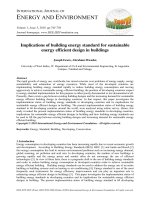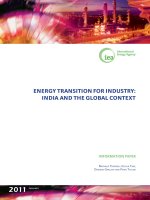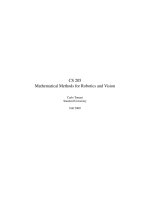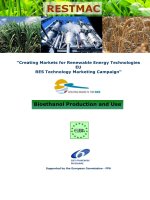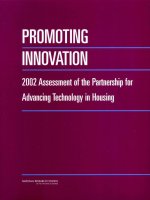National Energy Map for India: Technology Vision 2030 ppt
Bạn đang xem bản rút gọn của tài liệu. Xem và tải ngay bản đầy đủ của tài liệu tại đây (7.08 MB, 297 trang )
National Energy Map for India:
Technology Vision 2030
Office of the Principal Scientific Adviser,
Government of India
The Energy and Resources Institute
ISBN 81-7993-099-8
Published by
TERI Press
The Energy and Resources Institute
Darbari Seth Block
IHC Complex, Lodhi Road
New Delhi – 110 003, India
Tel. 2468 2100 or 2468 2111
Fax 2468 2144 or 2468 2145
India +91 • Delhi (0)11
E-mail
Web www.teriin.org
Office of the Principal Scientific Adviser,
Government of India
318, Vigyan Bhavan Annexe
Maulana Azad Road
New Delhi – 110 011, India
Tel. 2302 2112
Fax 2302 2113
India +91 • Delhi (0)11
Web www.psa.gov.in
Contents
Preface v
Acknowledgements vii
Project team ix
Tables xi
Figures xix
Acronyms and abbreviations xxiii
11
11
1 Introduction 1
22
22
2 Methodology 9
33
33
3 Sectoral demand projections, technological characterization,
and resources availability 29
44
44
4 Energy scenarios 139
55
55
5 Model results and analyses 149
66
66
6 Key observations and recommendations 193
appendicesappendices
appendicesappendices
appendices
A1A1
A1A1
A1
Description of energy sector models 207
A2A2
A2A2
A2
Sectoral reference energy system (RES) 215
A3A3
A3A3
A3 Socio-economic drivers of energy demand 221
A4A4
A4A4
A4 Region-wise hydrocarbon reserves at the end of 2005 235
A5A5
A5A5
A5 Sankey diagrams 241
A6A6
A6A6
A6 Balance sheets 249
Bibliography 253
iv Contents
Preface
India has recorded impressive rates of eco-
nomic growth in recent years, which provide
the basis for more ambitious achievements
in the future. However, a healthy rate of eco-
nomic growth equalling or exceeding the
current rate of 8% per annum would require
major provision of infrastructure and en-
hanced supply of inputs such as energy. High
economic growth would create much larger
demand for energy and this would present
the country with a variety of choices in terms
of supply possibilities. Technology would be
an important element of future energy strat-
egy for the country, because related to a
range of future demand and supply scenario
would be issues of technological choices
both on the supply and demand sides, which
need to be understood at this stage, if they
are to become an important part of India’s
energy solution in the future.
The Indian government aims to achieve
an economic growth rate of over 8% in the
next two decades in order to be able to meet
its development objectives. However, rapid
economic growth would also imply the need
for structural changes in the economy as well
as for induced shifts in the patterns of end-
use demands. To meet the needs of the In-
dian populace in the most effective manner,
it is important to map out the energy de-
mand and supply dynamics in the country.
This study estimates alternative trajectories
of energy requirements and examines the
likely fuel mix for the country under various
resource and technological constraints over
a 30-year time frame.
This study has been commissioned and
supported by the office of the PSA (Princi-
pal Scientific Advisor) to the Government of
India. The two-year study has drawn inputs
from several organizations and sectoral
experts across the country to gauge the like-
lihood of technological progress and avail-
ability of energy resources in the future.
The MARKAL model used in this study
is a widely used integrated energy system op-
timization framework that enables policy-
makers and researchers to examine the best
technological options for each stage of en-
ergy processing, conversion, and use. This
modelling framework was used to represent
a detailed technological database for the In-
dian energy sector with regard to energy re-
sources (indigenous extraction, imports, and
conversion) as well as energy use across the
five major end-use sectors (agricultural,
commercial, residential, transport, and in-
dustrial).
The report discusses the data, assump-
tions, and methodological framework used
to estimate useful energy requirements of
the country based on demographic and eco-
nomic drivers. Technological assessments of
resources and energy conversion processes
have been described in the report. Economic
and technological scenarios have been devel-
oped within the integrated modelling frame-
work to assess the best energy mix during the
modelling time frame. Based on the scenario
assessment, the report provides directions to
various stakeholders associated with the In-
dian energy sector including policy-makers,
technologists, and investors.
The report clearly points towards the
country’s increasing import dependence of
all fossil fuels. It also indicates that coal
would continue to play a key role in meeting
the country’s energy requirements. How-
ever, the indigenous availability of coal is
expected to plateau in the next couple of
decades with the current exploitation plans
and technology. The need for energy effi-
ciency in the end-use sectors and radical
policy changes in the transport sector is also
highlighted. The study points towards focus-
sing efforts simultaneously on the demand
and supply sides for the economy to attain
the most efficient utilization of available re-
sources.
(R K Pachauri)
Director-General, TERI
vi Preface
Acknowledgements
TERI acknowledges the high-level techni-
cal inputs and guidance provided by various
national experts in the development of the
model. TERI specially thanks the following
experts: R Chidambaram, Kirit Parikh, A K
Kolar, Kamal Kapoor, Brahma Deo, V K
Sharma, R B Grover, Srinivas Shetty, H S
Kamath, V K Agarwal, L M Das, P K Sen,
Adish Jain, Arun Kumar, Surya P Sethi,
Arvinder S Sachdeva, Prodipto Ghosh, Dilip
Chenoy, Sudhinder Thakur, P K Modi, Alok
Saxena, and S Nand.
TERI also acknowledges the input
provided by the following organizations:
Department of Atomic Energy, Nuclear
Power Corporation of India Ltd, Bharat
Heavy Electricals Ltd, National Thermal
Power Corporation Ltd, National Hydro
Power Corporation, North Indian Textiles
Manufacturers Association, Indian Rail-
ways, Oil and Natural Gas Corporation Ltd,
Engineers India Ltd, Indian Aluminum
Manufacturers Association, Steel Authority
of India Ltd, Fertilizer Association of India,
Cement Manufacturers Association, Con-
federation of Indian Industry, and Indian
Paper Manufacturers Association.
Thanks are due to Mr Rakesh Kumar
Arora for his invaluable secretarial assis-
tance.
Principal investigator Leena Srivastava
Core team Ritu Mathur, Pradeep K Dadhich, Atul Kumar,
Sakshi Marwah, Pooja Goel
Sector experts in TERI Amit Kumar, Shirish S Garud, Mahesh Vipradas,
V V N Kishore, Pradeep Kumar, Alok Adholeya,
Girish Sethi, N Vasudevan, Shashank Jain, Abhishek Nath,
Upasna Gaur, Ananya Sengupta, Parimita Mohanty,
K Rajeshwari, Ranjan K Bose, Sudip Mitra, R C Pal
Advisors R K Pachauri, R K Batra, Y P Abbi, S K Chand,
K Ramanathan, Preety M Bhandari
Project review monitoring S P Sukhatme, S K Sikka, E A S Sarma, Y S R Prasad,
committee R P Gupta, Chandan Roy, R K Saigal
Editorial and production Ambika Shankar, Archana Singh, Gopalakrishnan,
team Jaya Kapur, K P Eashwar, Richa Sharma, R K Joshi,
R Ajith Kumar, Subrat K Sahu, T Radhakrishnan
Project team
Table 1.1 Production of primary energy sources of conventional energy in India 2
Table 1.2 Estimated energy demand 6
Table 2.1 Demographic trends in India 15
Table 2.2 Assumptions for population projections 17
Table 2.3 Population projections (in million) 18
Table 2.4 Rural–urban distribution (%) as per the UNPD 18
Table 2.5 Rural–urban distribution (%) as per the Census of India 18
Table 2.6 Projected population and number of households in rural and
urban areas (million) 19
Table 2.7 Number of rural households (in million) in various expenditure
categories for 6.7% GDP growth 20
Table 2.8 Number of urban households (in million) in various expenditure
categories for 6.7% GDP growth 20
Table 2.9 Number of rural households (in million) in various expenditure
categories for 8% GDP growth rate 21
Table 2.10 Number of urban households (in million) in various expenditure
categories for 8% GDP growth rate 21
Table 2.11 Number of rural households (in million) in various expenditure
categories for 10% GDP growth rate 22
Table 2.12 Number of urban households (in million) in various expenditure
categories for 10% GDP growth rate 22
Table 2.13 Projections of GDP at factor cost at 1993/94 prices (in crore rupees)
under various GDP growth rate scenarios 23
Table 2.14 Sectoral composition of GDP (%) 25
Table 2.15 Sectoral GDP at factor cost (in crore rupees) under 6.7% GDP
growth rate scenario 26
Tables
Table 2.16 Sectoral GDP at factor cost (in crore rupees) under 8%
GDP growth rate scenario 26
Table 2.17 Sectoral GDP at factor cost (in crore rupees) under 10%
GDP growth rate scenario 26
Table 3.1 Projected cropping intensity and gross cropped area 32
Table 3.2 Demand for land preparation at various GDP (gross domestic
product) growth rates (in million hectares) 33
Table 3.3 GIA GCA under irrigation under various growth scenarios 34
Table 3.4 GIA under groundwater irrigation at various GDP growth rate scenarios 35
Table 3.5 Crop-wise GCA and water consumption 36
Table 3.6 Technology characterization of pump sets 38
Table 3.7 Comparison of transport sector demand estimates by various
agencies for the year 1999 41
Table 3.8 Comparison of transport sector demand estimates by various
agencies for the year 2000 41
Table 3.9 Assumptions on occupancy rate and utilization rate for cars 43
Table 3.10 Assumptions on occupancy rate and utilization rate for two-wheelers 46
Table 3.11 Assumptions on occupancy rate and utilization rate for buses 47
Table 3.12 Mode-wise road passenger travel demand (in billion passenger
kilometres) under 6.7% GDP (gross domestic product) growth scenario 47
Table 3.13 Mode-wise road passenger travel demand (in billion passenger
kilometres) under 8% GDP (gross domestic product) growth scenario 48
Table 3.14 Mode-wise road passenger travel demand (in billion passenger kilometres)
under 10% GDP (gross domestic product) growth scenario 48
Table 3.15 Mode-wise freight travel demand (in billion tonne kilometres); 6.
7% GDP (gross domestic product) growth scenario 49
Table 3.16 Mode-wise freight travel demand (in billion tonne kilometres);
8% GDP (gross domestic product) growth scenario 50
Table 3.17 Mode-wise freight travel demand (in billion tonne kilometres);
10% GDP (gross domestic product) growth scenario 50
Table 3.18 Rail passenger transport demand (in billion passenger kilometres)
under alternative GDP (gross domestic product) growth scenarios 51
Table 3.19 Rail freight transport demand (in billion tonne kilometres)
under alternative GDP (gross domestic product) growth rates 51
Table 3.20 Technological characterization of two-stroke two-wheelers 53
xii Tables
Table 3.21 Technological characterization of four-stroke two-wheelers 53
Table 3.22 Technological characterization of three-wheelers 54
Table 3.23 Percentage of cars sold by various manufacturers 55
Table 3.24 Technological characterization of cars 55
Table 3.25 Technological characterization of buses 56
Table 3.26 Technological characterization of goods vehicles 56
Table 3.27 Technological characterization of locomotives (freight) 56
Table 3.28 Technological characterization of locomotives (passenger) 57
Table 3.29 Estimates of bio-diesel production 57
Table 3.30 Assumptions in various transport scenarios 58
Table 3.31 Demand projection of caustic soda in India 60
Table 3.32 Projected demand of soda ash in India 60
Table 3.33 Demand projections of aluminium 61
Table 3.34 Demand projections for finished steel in India 62
Table 3.35 Cement demand projections 63
Table 3.36 Cotton cloth demand projection 64
Table 3.37 Demand projection for fertilizer 65
Table 3.38 Projected demand for paper and paper board in India 65
Table 3.39 Energy demand projection for other industries 66
Table 3.40 Production of caustic soda through different processes:
1998/99 to 2003/04 67
Table 3.41 Technological characterization of caustic soda industry 67
Table 3.42 Details of Indian soda ash plants 68
Table 3.43 Technological characterization of soda ash industry 68
Table 3.44 Technological characterization of the aluminium industry 70
Table 3.45 Production and technological details of Indian steel industry
during the year 2001/02 71
Table 3.46 Efficiency improvement measures for integrated steel plants 72
Table 3.47 Efficiency improvement measures for EAF-based steel plants 73
Table 3.48 Level of share of BF–BOF and Scrap-EAF steel plants 74
Table 3.49 Percentage distribution of cement production in the year 2002/03 74
Table 3.50 Percentage distribution of input material requirement for different
varieties of cement production in India 75
Table 3.51 Technological details of process-wise cement production in India 76
Tables xiii
Table 3.52 Variety-wise percentage distribution of cement production in
2001 and 2036 76
Table 3.53 Technological characterization of cotton textile industry 79
Table 3.54 Installed capacity according to sources of feedstock (percentage)
used for nitrogenous fertilizer production 80
Table 3.55 Specific energy consumption for urea production in India 80
Table 3.56 Technological characteristics of paper mills 82
Table 3.57 Energy conservation options for Indian paper mills 83
Table 3.58 Income categories based on MPCE in rural and urban areas 88
Table 3.59 Number of lighting points per household in various income
classes in rural and urban areas 88
Table 3.60 Demand for lighting (trillion lux hours) 89
Table 3.61 Useful energy demand for cooking (petajoules) 90
Table 3.62 Usage norms for electrical appliances 91
Table 3.63 Useful energy demand for various end uses at 6.7% GDP growth scenario 92
Table 3.64 Useful energy demand for various end uses (petajoules) at 6.7%
GDP growth rate 92
Table 3.65 Useful energy demand for various end uses (petajoules) at 10%
GDP growth rate 92
Table 3.66 Percentage distribution of households in various income groups
using sources other than geyser for heating water 93
Table 3.67 Useful energy demand for heating water (petajoules) at the three
GDP growth rates 94
Table 3.68 Techno-economic parameters for various lighting devices 95
Table 3.69 Techno-economic parameters for kerosene-based lighting devices 95
Table 3.70 Techno-economic parameters of various cooking devices 96
Table 3.71 Characterization of refrigerators 97
Table 3.72 Technological characterization of fans 97
Table 3.73 Technological characterization of air conditioners 98
Table 3.74 Characterization of washing machines, televisions, VCRs/ VCPs,
and music systems 98
Table 3.75 Technological options for cooking in the commercial sector 100
Table 3.76 Energy demand for cooking in commercial sector (in Mtoe) 101
Table 3.77 Technologies for lighting in the commercial sector 102
xiv Tables
Table 3.78 Electricity demand for lighting in the commercial sector (in GWh) 102
Table 3.79 Technologies for space conditioning in the commercial sector 102
Table 3.80 Electricity demand for space conditioning in the commercial
sector (in GWh) 103
Table 3.81 Electricity demand for refrigeration in the commercial sector (in GWh) 103
Table 3.82 Electricity demand projections for other services (in GWh) 104
Table 3.83 Maximum values of domestic coal availability 105
Table 3.84 Coal-bed methane production potential in India 108
Table 3.85 Company-wise crude oil production (MT) 110
Table 3.86 Company-wise production of natural gas (MCM) 110
Table 3.87 Progress during NELP rounds 112
Table 3.88 Oil refinery capacity in India (2005) 114
Table 3.89 Refining capacity, actual crude throughput, and capacity
utilization during the past five years 119
Table 3.90 New refineries planned in the Eleventh Five Year Plan 119
Table 3.91 Natural gas availability 120
Table 3.92 Prices of different types of coal in three different scenarios 121
Table 3.93 Price of crude and other petroleum products 122
Table 3.94 Prices of natural gas 122
Table 3.95 Power generation steam cycles with different unit ratings 123
Table 3.96 Contemporary gas turbines using natural gas as fuel—
performance at ISO conditions 124
Table 3.97 Advance class gas turbines—performance at ISO conditions 126
Table 3.98 Integrated gasification combined cycle experience in the world 128
Table 3.99 Cost comparison of different IGCC technologies (1989 pricing) 129
Table 3.100 Upper bound on installed capacity of large hydro-based power
generation (in GW) 131
Table 3.101 Installed capacity of nuclear energy based power generation 133
Table 3.102 Renewable energy source potential 134
Table 3.103 Techno-economic parameters of power generating technologies 137
Table 4.1 Installed capacity of nuclear-energy-based power generation 144
Table 4.2 Installed capacity of small hydro-based power generation 144
Tables xv
Table 4.3 Installed capacity of wind-based power generation 144
Table 4.4 Installed capacity of SPV- and biomass-based power generation
in aggressive renewable energy scenario 145
Table 4.5 Availability of bio-diesel for transportation 146
Table 4.6 Description of energy-efficient scenarios for the transport sector 147
Table 5.1 Commercial energy requirements in the BAU (Mtoe) 150
Table 5.2 Annual production, import, and import dependency of coal 152
Table 5.3 Production, import, and import dependency of non-coking coal in the
business-as-usual scenario 153
Table 5.4 Production, import, and import dependency of coking coal in the
business-as-usual scenario 153
Table 5.5 Sector-wise commercial energy consumption in the business-as-usual
scenario (in million tonnes of oil equivalent) 155
Table 5.6 Trends in sectoral shares in commercial energy consumption
(in percentage) 155
Table 5.7 Supply and consumption of coal (million tonnes) in the
business-as-usual scenario 157
Table 5.8 Supply and consumption of petroleum products (million tonnes)
in the business-as-usual scenario 157
Table 5.9 Supply and consumption of natural gas (billion cubic metres) in the
business-as-usual scenario 159
Table 5.10 Trend in the sectoral electricity consumption in the business-as-usual
scenario (in terrawatt hours) 160
Table 5.11 Variations in commercial energy consumption across various scenarios
(in Mtoe) 161
Table 5.12 Comparison of technology deployment for centralized and
decentralized power generation in the BAU and EFF scenarios for
2021 and 2031 (in GW) 166
Table 5.13 Production, import, and import dependency of petroleum products
across various scenarios in 2011 171
Table 5.14 Production, import, and import dependency of petroleum
products across various scenarios in 2031 172
Table 5.15 Comparison of commercial energy consumption across various
scenarios (in Mtoe) 176
xvi Tables
Table 5.16 Technology deployment (including decentralized) during 2021 and
2031 in the business-as-usual and high growth and their respective
hybrid scenarios (in GW) 178
Table 5.17 Coal consumption in various end-use sectors in 2011 (in Mtoe) 179
Table 5.18 Coal consumption in various end-use sectors in 2021 (in Mtoe) 179
Table 5.19 Coal consumption in various end-use sectors in 2031 (in Mtoe) 180
Table 5.20 Domestic production, net import, and import dependency of
petroleum products in 2021 181
Table 5.21 Domestic production, net import, and import dependency of
petroleum products in 2031 181
Table 5.22 Energy intensity (kgoe/Rs of GDP) for various scenarios 185
Table 5.23 Total commercial energy consumption in transport sector
(in Mtoe) across various scenarios 187
Table 5.24 Projected fuel mix in transport sector (in Mtoe) across scenarios
for 2011 187
Table 5.25 Projected fuel mix in transport sector (in Mtoe) for various
scenarios for 2021 188
Table 5.26 Projected fuel mix in transport sector (in Mtoe) for various
scenarios for 2031 188
Table 5.27 Cumulative carbon dioxide emissions for different scenarios
(from 2001 to 2036) 193
Table 6.1 Suggested technology deployment programme 201
Table 6.2 Suggested technology deployment pathway for power generation 202
Table 6.3 Suggested technology deployment pathway for end-use sectors 203
Tables xvii
Figures
Figure 2.1 Schematic representation of methodological framework 10
Figure 2.2 Energy sector models 11
Figure 2.3 MARKAL building blocks 13
Figure 2.4 Share of sectoral GDP in aggregate GDP (%) 24
Figure 3.1 Area under cultivation in India (million hectares) 30
Figure 3.2 Food grain production in India (million tonnes) 30
Figure 3.3 Trends in composition of fleet of registered passenger vehicles 39
Figure 3.4 Trends in passengers and freight carried by railways 40
Figure 3.5 Category-wise sales of two-wheelers 52
Figure 3.6 Primary aluminium production 69
Figure 3.7 Time trend of specific energy consumption of SAIL steel plants 71
Figure 3.8 Time trend of process profile of cement industry 74
Figure 3.9 Time trend of percentage distribution of different variety of
cement in India 75
Figure 3.10 Time trend of fuel and electricity consumption in the residential sector 85
Figure 3.11 Percentage distribution of households by source of cooking in rural India 86
Figure 3.12 Percentage distribution of households by source of cooking in urban India 86
Figure 3.13 Number of households per 1000 in highest income class possessing
specified durable goods (rural) 90
Figure 3.14 Number of households per 1000 in highest income class possessing
specified durable goods (urban) 91
Figure 3.15 Trend of electricity consumption in the commercial sector (1980–2003) 101
Figure 3.16 Trend of electricity consumption in other electricity consuming
sectors (1980–2003) 104
Figure 3.17 Production and import of crude oil over the years 111
Figure 3.18 Improvement in heat rates with steam parameters 125
Figure 3.19 Economic impact of Integrated gasification combined cycle
design study improvements 129
Figure 5.1 Commercial energy use in the business-as-usual 150
Figure 5.2 Percentage share of fuel mix (business-as-usual scenario) 151
Figure 5.3 Variation in percentage share of traditional fuels in total primary
energy supply 151
Figure 5.4 Production, import, and import dependency of non-coking coal in the
business-as-usual scenario 152
Figure 5.5 Production, import, and import dependency of coking coal in the
business-as-usual scenario 153
Figure 5.6 Production, import, and import dependency of natural gas
in the business-as-usual scenario 154
Figure 5.7 Production, import, and import dependency of petroleum in the
business-as-usual scenario 154
Figure 5.8 Sector-wise commercial energy consumption in the business-as-usual
scenario 155
Figure 5.9 Trends in sectoral shares in commercial energy consumption 156
Figure 5.10 Sectoral consumption of petroleum products in the business-as-usual
scenario 158
Figure 5.11 Trend in the sectoral electricity consumption in the business-as-usual
scenario 159
Figure 5.12 Trends in percentage distribution of electricity consumption in the
business-as-usual scenario 160
Figure 5.13 Total commercial energy consumption across scenarios 162
Figure 5.14 Average annual fuel cost across various scenarios 162
Figure 5.15 Comparison of electricity consumption across various scenarios 163
Figure 5.16 Comparison of power generation capacity mix (including
decentralized) across various scenarios 164
Figure 5.17 Average annualized investment cost in the centralized power
generation across various scenarios 165
Figure 5.18 Comparison of fuel-wise technology deployment in the
business-as-usual and high-efficiency scenarios in the power sector 167
Figure 5.19 Sector-wise coal consumption across different scenarios for 2011,
2021, and 2031 168
xx Figures
Figure 5.20 Comparison of import dependency of coking coal across various
scenarios 169
Figure 5.21 Import dependency of non-coking coal across various scenarios 169
Figure 5.22 Comparison of average annual cost of coal across various scenarios 170
Figure 5.23 Production, import, and import dependency of petroleum products across
various scenarios in 2011 170
Figure 5.24 Production, import, and import dependency of petroleum products across
various scenarios in 2031 171
Figure 5.25 Average annual cost of oil and oil products across various scenarios 172
Figure 5.26 Comparison of petroleum product consumption across various
scenarios in the end-use sectors 173
Figure 5.27 Refinery capacity across various scenarios 174
Figure 5.28 Refinery investment cost across various scenarios 174
Figure 5.29 Import of natural gas across various scenarios 175
Figure 5.30 Average annual cost of natural gas across various scenarios 175
Figure 5.31 Commercial energy supply in 2011, 2021, and 2031 177
Figure 5.32 Generation capacity mix for 2011, 2021, and 2031 (centralized and
decentralized) 177
Figure 5.33 Comparison of fuel-wise technology deployment for power
generation across various scenarios for 2021 178
Figure 5.34 Comparison of fuel-wise technology deployment for power
generation across various scenarios for 2031 179
Figure 5.35 Sectoral electricity consumption for 2011, 2021, and 2031 180
Figure 5.36 Import dependency of coking coal across various scenarios for
2011 and 2031 181
Figure 5.37 Import dependency of non-coking coal across various scenarios in
2011 and 2031 182
Figure 5.38 Domestic production, net import, and import dependency of
petroleum products for 2021 182
Figure 5.39 Domestic production, net import, and import dependency of
petroleum products for 2031 183
Figure 5.40 Import of natural gas across various scenarios for 2011, 2021, and 2031 183
Figure 5.41 Sectoral consumption of petroleum products in 2011, 2021, and 2031 184
Figure 5.42 Trends in energy intensity across various scenarios from 2001 to 2031 185
Figure 5.43 Comparison of energy consumption in transport sector across various
scenarios 186
Figures xxi
Figure 5.44 Comparison of fuel mix in transport sector across scenarios for
2011, 2021, and 2031 189
Figure 5.45 Comparison of net import and import dependency of petroleum
products across various scenarios for 2011, 2021, and 2031 191
Figure 5.46 Expenditure incurred on import of petroleum products 192
Figure 5.47 Cumulative carbon dioxide emissions across various scenarios (2001–36) 193
xxii Figures
Acronyms and abbreviations
AC Air conditioner
ADB Asian Development Bank
AHP Analytic Hierarchy Process
AIM Asia–Pacific Integrated Model
AMAI Alkali Manufacturers’ Association of India
ARIMA Auto regressive integrated moving average
ATF Aviation turbine fuel
BALCO Bharat Aluminium Company Ltd
BAU Business-as-usual
Bbl Barrel
BCM Billion cubic metres
BCPP Biomass consumption based power project
BEE Bureau of Energy Efficiency
BF–BOF Blast furnace–basic oxygen furnace
BHEL Bharat Heavy Electricals Ltd
BHH Bayer–Hall–Heroult
BIODSL Bio-diesel
bkWh Billion kilowatt-hours
BOF Basic oxygen furnace
BPCL Bharat Petroleum Corporation Ltd
bpkm Billion passenger kilometres
BPL Below poverty line
BRPL Bongaigaon Refinery and Petrochemicals Ltd
BRUS Brundtland Scenario Model
BT Billion tonnes
btkm Billion tonne kilometres
Btu British thermal unit
CAGR Compounded annual growth rate
CBM Coal bed methane
CCGT Combined cycle gas turbine
CCPP Combined cycle power plant
